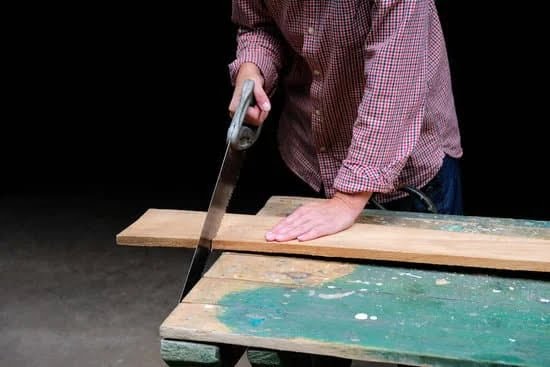Woodwork is a timeless craft that requires precision, patience, and the right tools. One of the most essential components of woodworking is the proper application of glue. Knowing how to apply glue to woodwork is crucial for ensuring strong and durable bonds between wood pieces. Whether you’re a seasoned woodworker or just starting out, understanding the different types of wood glue and mastering the art of gluing is essential for creating high-quality projects.
When it comes to woodworking, choosing the right type of wood glue can make all the difference in the strength and longevity of your project. From standard yellow glue to epoxy and polyurethane adhesives, each type has its own unique features and uses. In this article, we will explore the various types of wood glue and when to use them for different woodworking applications.
In addition to selecting the appropriate type of glue, preparing the wood surface for gluing is equally important. Proper surface preparation ensures maximum adhesion between wood pieces and prevents potential bonding issues down the line. From cleaning and sanding to applying moisture barriers, we will discuss how to properly prepare your wood surfaces for gluing in order to achieve optimal results. Let’s dive into the world of woodworking and learn how to expertly apply glue to your next project.
Different Types of Wood Glue and Their Uses
When it comes to woodworking, selecting the right type of wood glue can make a significant difference in the strength and durability of your project. There are several different types of wood glue available, each with its own unique properties and best uses. Understanding the differences between these glues can help you make the best choice for your specific woodworking needs.
PVA (Polyvinyl Acetate) Glue
PVA glue is one of the most commonly used types of wood glue. It is known for its strong bond, ease of use, and water-based nature. PVA glue dries clear, making it ideal for projects where appearance matters. This type of wood glue is suitable for most woodworking applications, including assembling furniture, cabinetry, and general woodworking projects.
Polyurethane Glue
Polyurethane glue is a waterproof adhesive that creates an incredibly strong bond. This type of glue is ideal for outdoor projects or any application where the wood will be exposed to moisture. It also expands as it cures, filling in gaps and creating a solid bond even on rough or uneven surfaces.
Cyanoacrylate (CA) Glue
Also known as super glue, cyanoacrylate adhesive is a fast-acting and incredibly strong option for bonding wood. It’s best suited for small repairs or when a quick bond is needed. CA glue works well on both porous and non-porous materials, making it versatile for various woodworking applications.
Knowing how to apply glue to woodwork starts with understanding the different types of wood glues available and their recommended uses. By choosing the right type of wood glue for your project, you can ensure a strong, long-lasting bond that will withstand the test of time.
Preparing the Wood Surface for Gluing
As you prepare to apply glue to woodwork, it is crucial to ensure that the wood surface is properly prepared for the gluing process. Proper preparation will result in a stronger and more durable bond between the pieces of wood. Here are some steps to follow when preparing the wood surface for gluing:
1. Clean the Surface: Before applying glue, make sure that the wood surface is clean and free from any dust, dirt, or debris. Use a damp cloth to wipe down the surfaces that will be glued together. This will help ensure that the glue adheres properly and that there are no contaminants that could weaken the bond.
2. Sanding the Wood: It is important to sand the wood before gluing to create a smooth and even surface for better adhesion. Start with a coarse-grit sandpaper to remove any rough spots or imperfections on the wood. Then, use a finer-grit sandpaper to achieve a smooth finish.
3. Moisture Content: Check the moisture content of the wood before applying glue. Wood with high moisture content can affect the strength of the glue joint. It is recommended to use a moisture meter to ensure that the wood has an appropriate moisture level for gluing.
Properly preparing the wood surface for gluing will ensure a strong bond and increase the chances of a successful woodworking project. By following these steps, you can effectively prepare your wood surfaces for glue application and achieve professional-looking results.
| Preparing Wood Surface Steps | Description |
|---|---|
| Clean the Surface | Ensure that no dust or debris remains on the wood surface before applying glue. |
| Sanding | Use coarse-grit sandpaper followed by finer-grit sandpaper to achieve a smooth surface. |
| Moisture Content | Check and ensure appropriate moisture levels in the wood before gluing. |
Applying the Glue to Woodwork
Selecting the Right Type of Glue
When it comes to applying glue to woodwork, the first step is selecting the right type of glue for the job. There are various types of wood glue available, including yellow woodworking glue, polyurethane glue, epoxy, and cyanoacrylate (super glue). Each type of glue has its own specific uses and properties, so it’s important to choose the one that best suits your project needs.
Cleaning and Preparing the Wood Surface
Before applying any glue, it’s crucial to ensure that the wood surface is clean and free from any dust, debris, or previous finishes. Use a clean cloth to wipe down the surfaces that will be glued together, and if necessary, sand down any rough spots or uneven areas. This will ensure that the glue adheres properly and creates a strong bond between the wood pieces.
Applying the Glue Step-by-Step
Once the wood surface is prepared, it’s time to apply the glue. Start by carefully applying a thin and even layer of glue onto one of the surfaces that will be joined together. It’s important not to use too much glue as this can lead to excess squeeze-out and messy clean-up later on.
After applying the glue, carefully press the two wood pieces together and ensure that they are aligned correctly. Use clamps or weights to keep the pieces in place while the glue sets.
By following these step-by-step instructions on how to apply glue to woodwork, you can ensure that your woodworking projects are strong and durable. Properly applying wood glue is essential for creating long-lasting bonds between wood pieces, whether you are working on furniture construction or smaller craft projects.
Clamping and Curing the Glued Wood
After applying the glue to woodwork, the next crucial step is to properly clamp and cure the glued wood. This process is essential for creating a strong and durable bond between the pieces of wood. Here are some steps to ensure that you achieve a successful clamping and curing of your glued wood:
1. Use the right clamps: Depending on the size and shape of the wood pieces being glued together, choose the appropriate clamps. Whether it’s bar clamps, pipe clamps, or C-clamps, make sure that they are long enough to cover the entire surface of the glued area and provide even pressure.
2. Apply consistent pressure: Once you have positioned the clamps over the glued wood, tighten them just enough to apply consistent pressure along the entire glued area. Be careful not to over-tighten, as this can squeeze out too much glue and weaken the bond.
3. Allow for proper curing time: Different types of wood glue have varying curing times, so be sure to follow the manufacturer’s recommendations. Typically, it is best to leave the clamped wood undisturbed for at least 24 hours to ensure that the glue has fully cured.
4. Check for squeeze-out: After clamping, check for any excess glue that may have squeezed out from between the pieces of wood. Use a damp cloth or a chisel to carefully remove any excess glue before it dries.
Remember that proper clamping and curing are essential for achieving a strong and lasting bond between pieces of wood when using glue in woodworking projects.
– Properly align each piece with correct pressure adjustments.
– Allow sufficient time for curbing.
Tips and Tricks for Successful Glue Application
Woodworking projects often require the use of glue to firmly bond wood pieces together. However, applying glue to woodwork requires a certain level of skill and technique to ensure a strong and lasting bond. In this section, we will discuss some tips and tricks for successful glue application that will help you achieve professional-looking results.
Firstly, it is crucial to choose the right type of wood glue for your project. There are various types of wood glue available, such as PVA (polyvinyl acetate) glue, polyurethane glue, and epoxy, each with its own unique characteristics and ideal uses. For example, PVA glue is best for indoor woodworking projects, while polyurethane glue is suitable for outdoor applications due to its water-resistant properties.
Once you have chosen the appropriate wood glue for your project, it is important to prepare the wood surface before applying the adhesive. Make sure that the surfaces to be glued are clean, smooth, and free from any dust or debris. This can be achieved by sanding the wood with fine-grit sandpaper and wiping it down with a tack cloth before applying the glue. This step will ensure maximum adhesion and a strong bond between the wood pieces.
Another essential tip for successful glue application to woodwork is to apply an even layer of adhesive on the surfaces to be bonded. Too much or too little glue can result in weak joints and compromised structural integrity. Use a small paintbrush or a roller to evenly spread the glue on both surfaces, ensuring that there are no gaps or air pockets between the pieces of wood.
In summary, mastering how to apply glue to woodwork requires attention to detail and an understanding of different types of wood glues and their uses. By following these tips and tricks for successful glue application, you can achieve professional results in your woodworking projects.
| Tips | Tricks |
|---|---|
| Choose the right type of wood glue | Prepare the wood surface properly |
| Apply an even layer of adhesive | Achieve professional results |
Common Mistakes to Avoid When Applying Glue to Woodwork
When it comes to applying glue to woodwork, there are several common mistakes that can negatively impact the strength and quality of the bond. Avoiding these mistakes is crucial to ensuring a successful and long-lasting glue application.
Here are some common mistakes to avoid when applying glue to woodwork:
1. Inadequate surface preparation: Before applying glue, it’s important to ensure that the wood surfaces are clean, dry, and free of any residue or debris. Failing to prepare the surfaces properly can prevent the glue from creating a strong bond.
2. Using the wrong type of glue: Different types of wood glues are available, each designed for specific applications. Using the wrong type of glue for a particular project can result in a weak bond or even damage to the wood.
3. Applying too much or too little glue: Applying an excessive amount of glue can lead to messy, uneven bonds, while using too little glue may result in weak adhesion. It’s essential to follow the manufacturer’s recommended guidelines for the correct amount of glue to use.
To ensure a successful glue application to woodwork, it’s important to be mindful of these common mistakes and take steps to avoid them during your project.
- Prepare the wood surface by sanding it until smooth
- Choose the appropriate type of wood glue for your specific project
- Apply a thin, even layer of glue using a brush or roller
By following these tips and avoiding common mistakes, you can achieve strong and durable bonded woodwork that will stand the test of time.
- Use clamps or weights to hold the glued pieces together securely
- Allow sufficient time for the glued wood pieces to cure before handling them
- After curing, finish and sand the glued wood as needed for a professional-looking result
Finishing and Sanding the Glued Wood
After clamping and curing the glued wood, the next step in the woodwork project is finishing and sanding the glued wood. This step is crucial to ensure a smooth and polished look for the final product. Proper finishing and sanding not only enhances the appearance of the woodwork but also improves its durability.
Before starting the finishing process, it is important to remove any excess glue that may have squeezed out during clamping. This can be done using a chisel or scraper to carefully remove the hardened glue without damaging the wood surface. After removing any excess glue, allow the wood to fully cure according to the instructions provided by the specific type of glue used.
Once the glued wood has fully cured, it is time to move on to the sanding process. Start with a coarse-grit sandpaper to even out any uneven surfaces or edges caused by gluing. Gradually move on to finer grits of sandpaper to achieve a smooth and seamless finish.
It is important to sand in the direction of the wood grain to avoid causing any scratches or damage to the surface. After achieving a smooth finish, wipe off any dust particles using a tack cloth before applying any finishes such as varnish or paint.
In mastering the art of glue application to woodwork, finishing and sanding are essential steps that contribute significantly to the overall quality of your project. Taking time and care in this step will ensure a professional-looking result that will be both visually appealing and long-lasting. And that’s how you apply glue properly onto your woodworks for a perfect finish.
Conclusion
In conclusion, mastering the art of glue application to woodwork is an essential skill for any woodworker or DIY enthusiast. Understanding the different types of wood glue and their uses is crucial in ensuring a successful bonding process. Whether you are working with porous or non-porous surfaces, having the knowledge of how to apply glue to woodwork will make your projects more efficient and durable.
The step-by-step guide provided in this article gives a clear understanding of the process involved in preparing the wood surface, applying the glue, and clamping and curing the glued wood. Following these steps diligently will result in strong and lasting bonds between pieces of wood.
Furthermore, being aware of common mistakes to avoid when applying glue to woodwork, as well as using tips and tricks for successful glue application, will enhance your woodworking skills. Additionally, finishing and sanding the glued wood properly will give your project a professional and polished look.
By incorporating all these aspects into your woodworking projects, you can achieve high-quality results that will stand the test of time. Mastering how to apply glue to woodwork is an important aspect of woodworking that can elevate the quality and longevity of your creations.
Frequently Asked Questions
What Is the Best Way to Apply Wood Glue?
The best way to apply wood glue is by using a small, disposable brush or a wooden stick to spread the glue evenly on the surface. It’s important to apply just enough glue to create a strong bond without excessive oozing.
What Is the Best Tool to Apply Wood Glue?
The best tool for applying wood glue is a small, disposable brush. This allows for precise application and even distribution of the glue on the surface of the wood. A wooden stick can also work well for spreading the glue.
How Do You Apply Glue Properly?
To apply wood glue properly, start by ensuring that the surfaces to be glued are clean and dry. Then, use a small brush or wooden stick to spread an even layer of glue on one of the surfaces.
Press the surfaces together firmly and wipe off any excess glue that squeezes out. Allow sufficient drying time as per the glue’s instructions before handling the glued object.

Hi everyone! I’m a woodworker and blogger, and this is my woodworking blog. In my blog, I share tips and tricks for woodworkers of all skill levels, as well as project ideas that you can try yourself.





